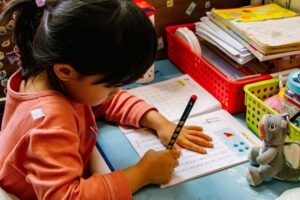
In today’s diverse classroom settings, teachers play a crucial role in creating an inclusive environment where every child can thrive. One group of students that may require special attention and support are those with autism spectrum disorder (ASD). Applied Behavior Analysis (ABA) therapy provides valuable techniques for educators to enhance the learning experience and social integration of children with autism.
In this blog, we will explore practical strategies that teachers can implement to provide effective support to children with autism in their classrooms.
Understanding Autism and ABA Therapy
Autism spectrum disorder is a complex neurological condition that affects individuals’ communication, social interaction, and behavior. Each child with autism is unique, with varying strengths and challenges.
Autism is a disability covered by the Individuals with Disabilities Education Act (IDEA). Under this law, students are entitled to experience the least restrictive environment where they have the greatest possible opportunity to interact and learn with their peers without disabilities and to participate in the general education curriculum. Accommodations are not privileges; they are rights.
Applied Behavior Analysis is an evidence-based therapy approach that focuses on analyzing and modifying behaviors through systematic and structured interventions. ABA is highly effective in addressing behaviors associated with autism and promoting positive social interactions and learning outcomes.
Creating a Supportive Environment
-
Structured Routine: Children with autism thrive in structured environments. Establish a consistent daily routine that includes clear schedules, visual cues, and transitions. This predictability helps reduce anxiety and facilitates smoother transitions between activities.
-
Visual Supports: Visual aids can serve as reminders about classroom rules, where certain things go, and resources that are available to students. Using pictures and modeling will mean more to students with autism than a lengthy explanation. Utilize visual aids such as visual schedules, social stories, and visual cues to enhance communication and understanding.
-
Sensory Considerations: Recognize and accommodate sensory sensitivities. Many unexpected things can be distracting and make it difficult for students with autism to concentrate. Using cool, calm colors in the classroom can help create a more relaxing atmosphere. Avoid covering the walls with too many posters or other things to look at. Create a sensory-friendly classroom by providing quiet spaces, sensory tools, and minimizing sensory overload.
-
Clear Communication: Use simple and concise language when delivering instructions. Be direct and avoid any figurative language unless that is the lesson. Offering visual and verbal cues to reinforce your communication and the child’s comprehension.
-
Treat Students as Individuals: This should go without saying, but it’s important to model patience, understanding, and respect when working in a classroom with any special learners for them and for their fellow students. Celebrate their success, and don’t sweat it if some accommodations don’t conform to what you are used to in the classroom.
Implementing ABA Techniques
-
Positive Reinforcement: ABA emphasizes positive reinforcement to encourage desired behaviors. Identify specific behaviors or skills you want to promote, and offer immediate rewards such as praise, tokens, or preferred activities of the child when those behaviors occur.
-
Task Analysis: Break down complex tasks into smaller, manageable steps. Similar to our social post on teaching handwashing by breaking it down into steps. This approach helps children with autism feel a sense of accomplishment as they gradually master each step of a task.
-
Prompting and Fading: Use prompts to guide the child’s behavior initially and gradually reduce the level of assistance as the child becomes more independent. Meaning if the child is stumbling on the steps, remind them what to do next. This technique helps children learn new skills at their own pace.
-
Support Any Support Staff: Work together with any support staff a child might have assigned to them as part of their Individualized Education Plan (IEP). It is important to understand the student isn’t just yours and that you’ll be teaching the child with the assistance of others.
Promoting Social Interaction
-
Peer Interactions: Encourage peer interactions through structured group activities and cooperative learning projects. Pairing children with autism with neurotypical peers can facilitate social skill development and encourages acceptance.
-
Social Skills Training: Incorporate explicit social skills instruction into the curriculum. Role-playing, video modeling, and scripted interactions can help children with autism understand and practice social norms.
-
Inclusive Games: Modify games and activities to ensure that children with autism can participate and experience success. Adapt rules and provide clear guidelines to promote inclusivity. This could mean giving children long periods between turns, quieting loud noises/cheers, or even making it easier to score points in a game.
Conclusión
Inclusive education is a shared responsibility that requires collaboration between educators, therapists, parents, and the broader community. Applied ABC offers valuable tools and techniques to support children with autism in classrooms through ABA therapy.
It is important to understand that an educator’s role is to guide the child and not try to change who that child is. None of us can predict the future outcomes for a child or what they may achieve later in life. Good teaching fosters growth and development, paving the way for a child to reach their full potential.
By creating a structured environment, being understanding, and promoting social interaction, teachers can foster a positive and enriching learning experience for all students. With dedication and a commitment to each child’s unique needs, we can all make a profound difference in the lives of children with autism.
Fuentes citadas:
J. Roberts, & A. Webster. Including students with autism in schools: a whole school approach to improve outcomes for students with autism.
K., Crosland & G. Dunlap. Effective Strategies for the Inclusion of Children With Autism in General Education Classrooms.
S., Lynch, & A., Irvine. Inclusive education and best practice for children with autism spectrum disorder: an integrated approach.






